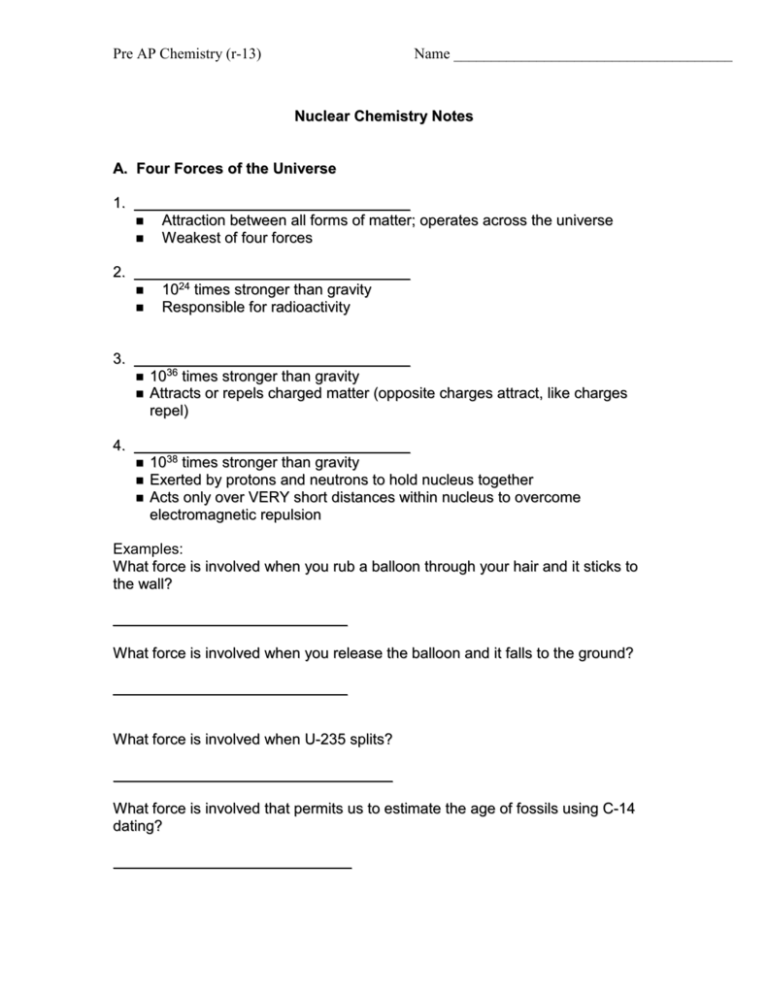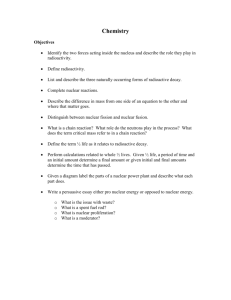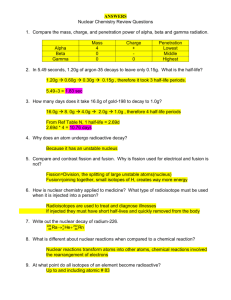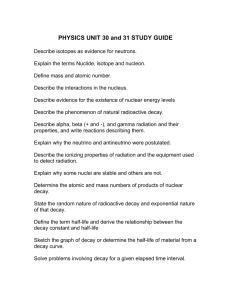Nuclear Chemistry Notes
advertisement

Pre AP Chemistry (r-13) Name _____________________________________ Nuclear Chemistry Notes A. Four Forces of the Universe 1. _________________________________ Attraction between all forms of matter; operates across the universe Weakest of four forces 2. _________________________________ 1024 times stronger than gravity Responsible for radioactivity 3. _________________________________ 1036 times stronger than gravity Attracts or repels charged matter (opposite charges attract, like charges repel) 4. _________________________________ 1038 times stronger than gravity Exerted by protons and neutrons to hold nucleus together Acts only over VERY short distances within nucleus to overcome electromagnetic repulsion Examples: What force is involved when you rub a balloon through your hair and it sticks to the wall? ____________________________ What force is involved when you release the balloon and it falls to the ground? ____________________________ What force is involved when U-235 splits? ____________________________ What force is involved that permits us to estimate the age of fossils using C-14 dating? ____________________________ B. Chemical Reactions vs. Nuclear Reactions Chemical Reactions vs Nuclear Reactions Occur when bonds between atoms are broken or formed Occur when a nucleus is changed and particles and/or rays are emitted Atoms are not changed, just rearranged Atoms are converted into atoms of another element; change in # of p+ Involves only valance electrons Involves protons, neutrons, and electrons Small energy changes VERY LARGE energy changes Reaction rate is affected by temperature, pressure, concentration, and catalysts Reaction rate unaffected by these C. Radioactivity Substances that ____________________ emit radiation are said to be ____________________. Nucleons = _______________ and _______________ _______________: atoms identified by the number of protons and neutrons in the nucleus. Example: radium-228 or 228 88 Ra; specific isotopes such as C-12 and C-13 All ____________________ elements and all elements with atomic number higher than _____ are unstable and therefore radioactive. 2 Unstable systems gain _______________ by losing _______________. The primary factor of determining how stable an atom is its ratio of ____________________ to ____________________. The force that acts on subatomic particles that are extremely close together and keeps the nucleus together is known as _______________ _______________ _______________ . Unstable nuclei lose energy through radioactive decay to form a nucleus with a stable number of _____ and _____ In atoms with low atomic numbers, the proton to neutron ratio in stable nuclei is +/- __________ In atoms with high atomic numbers, the proton to neutron ratio in stable nuclei is +/- __________ The Band of Stability: 3 _______________ _______________– the spontaneous process of an unstable nuclei losing energy by emitting radiation; occurs naturally Unstable radioactive atoms will undergo radioactive decay until they form stable atoms, often of a _______________ _______________. D. Types of Radiation Isotopes of atoms with unstable nuclei are called ___________________. During radioactive decay, unstable atoms lose energy by emitting one of several types of radiation, the three most common are _______________, _______________, and _______________. Type of radiation Greek Symbol Description of Radiation Alpha Beta Gamma α β y Electrons Photons Helium Nuclei Often accompanies alpha or beta decay Nuclear Symbol Charge Mass Penetrating Power 42He 0-1e 00γ +2 -1 0 4 amu 0 amu 0 amu Least penetrating due to large mass and charge Can cause harm through ingestion or inhalation Blocked by paper; cannot penetrate skin 4 Penetrating ability 100 times greater than that of alpha particles Travels at speeds close to speed of light Blocked by metal foil Greatest penetrating ability Protection requires thick layers of lead, concrete, or both Example of alpha decay: Example of beta decay: Example of gamma radiation: 238 92U 137 Cs 55 4 2 He + 23490Th 137 Ba 56 137 Ba 56 + 0 e-1 137 Ba 56 + 0 y 0 E. Writing Nuclear Equations To write nuclear equations, just make sure the sum of the mass numbers on the left and right sides of the arrows are the same, and that the atomic numbers add up too! Think of the → as an =. 226 Ra 88 mass #: atomic #: 22286Rn + 42He 226 222 + 4 88 86 + 2 Example #1 Decay of Thorium–230 by alpha emission Example #2 Decay of Carbon–14 by beta emission Example #3 238 92 U 42He + _____ + 00y Example #4 _____ 129 Xe 54 + 0 e -1 5 Example #5 _____ + 1 n 0 7 Li 3 Example #6 _____ + 0 e -1 82 Rb 37 Example #7 238 U + 4 He 92 2 24094Pu + _____10n F. Transmutation Transmutation is the___________________________________________ All _______________ _______________are transmutation reactions Transmutations can be induced (forced) by _______________ a stable nucleus with high-energy alpha, beta, or gamma radiation To overcome the repulsion between charged particles (like alpha particles) and the target nucleus, the particles must be moved at extremely ____________ ____________ This is accomplished by using a _______________ _______________ (also called Atom Smashers or Super Colliders) Stanford Linear Accelerator: Stanford University in California 2 miles long Operational in1966 (first) Large Hadron Collider Geneva, Switzerland Circular 17 mile tunnel (largest) Built from 1998 to 2008 G. Transuranium Elements All elements immediately following Uranium on the periodic table (#_____ and above) are called the transuranium elements. 6 The transuranium elements were all _______________ _____ _____ _______________ by induced transmutation. H Half-Life Not all isotopes ____________ at the same rate Radioactive decay is _______________ in half-lives Half-life – the time required for one half of a radioisotope’s nuclei to decay into its peoducts. For example: The half -life of strontium-90 is about 25 years. This means if you had 100.0 g of strontium-90 today, you would have 50.0 g left 25 years from now, 25.0 grams would remain after 50 years, and 12.5 grams would be left after 75 years. The decay would continue until negligible strontium-90 remained. Common Half-Lives: Carbon-14 dating is used to measure the age of objects up to 24,000 years old. Uranium-238 (to lead-206) is used for dating objects for up to several billion years old. 7 Half-Life Calculations The formula for calculating half-life is: Mf = (Mi)(.5)n Where: Mf = final mass Mi = initial mass n = the number of half-lives passed And: n = total time elapsed length of 1 half life or n = _t_ T Example #1 If Gallium-68 has a half-life of 68.3 minutes, how much of a 20.0 g sample is left after two half-lives? (3 sf) Example #2 The half-life of Iron-59 is 44.5 days. If 0.295 mg remains after 23.5 days, what was the mass of the original sample? (3 sf) Hint: solve for n then plug it into equation. 8 Example #3 What is the half-life of francium-224 if a 200.0 g sample decays to 75.0 g in 12.1 days? (3 sf) I. Nuclear Reactions and Energy _______________ _______________are much more efficient at providing energy than _______________ _______________ _______________ For example: The energy released from the nuclear reaction of _____ _______________ of uranium is roughly equivalent to the energy released by the chemical combustion of _____ __________ _______________ of coal! In nuclear reactions, the mass of the products is less than the mass of the reactants which seems to violate the Law of Conservation of Mass. However, the missing mass, known as the _______________ _______________, is converted into energy. E = mc2 9 J. Fission vs. Fusion Fission Nuclear ____________ is the ____________ of nuclei The fission of a nucleus is accompanied by a very large release of ___________ The mass of the products is less than the mass of the reactants. The missing mass, called the __________ __________, is converted into energy. If a sample is large enough to reach ____________ __________, the particles released from a nuclear reaction can cause a nuclear reaction in other atoms, causing a __________ ____________ Uranium-235 Fission Reaction: Fusion Nuclear _______________ is the ________________ of two or more light, less stable nuclei (mass < 60) into a single more stable nucleus and the subsequent release of energy. Particles must travel at ____________ ____________ ____________ to fuse Think of hitting two pool balls at each other so hard that instead of bouncing off one another, they instead ____________ into one 10 Nuclear fusion is what powers the sun The sun’s reaction:____________________________________________ In one second, the sun produces more energy than the entire amount of energy produced by human civilization since its inception! Advantages of Fusion over Fission Fusion produces __________ __________ than fission (about 100X) Fusion does not produce _______________ ____________, fission does The raw materials for fusion are readily available because hydrogen is one of the most _______________ elements (think water) Problems with Fission _______________ ____________- how and where to store it Public concern with ____________ Problems with Fusion _______________- no solid can withstand conditions necessary for reactions to occur (scientists use magnetic fields to contain plasma) _______________- at present, as much energy is needed to start a reaction as is produced 11 K. Uses for Nuclear Chemistry Nuclear Power Plants- heat water to form steam, turns generator magnets Radioactive Dyes- provide contrast in medical tests Radiation Therapy - high energy particles kill tumor cells (cancer treatment) PET Scans- Positron Emission Tomography; used in mapping brain function and locating lesions, etc. Radioisotope Dating- determine ages of fossils, etc. Nuclear Weapons- The H-Bomb is based on the fusion of Hydrogen 12








